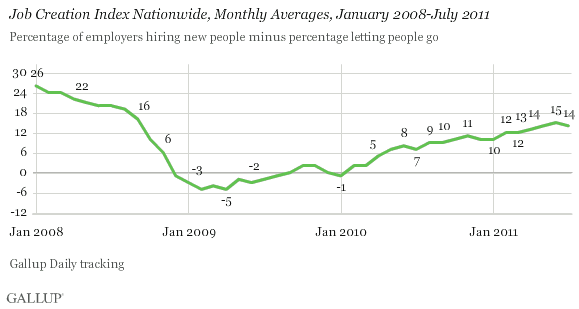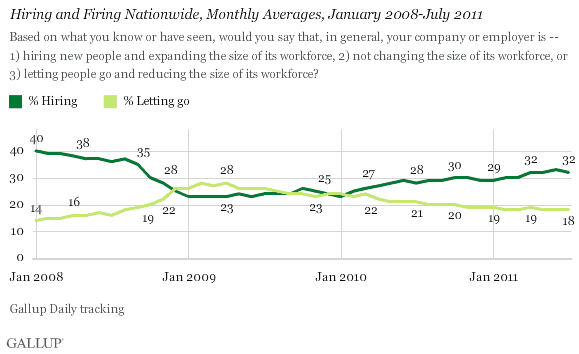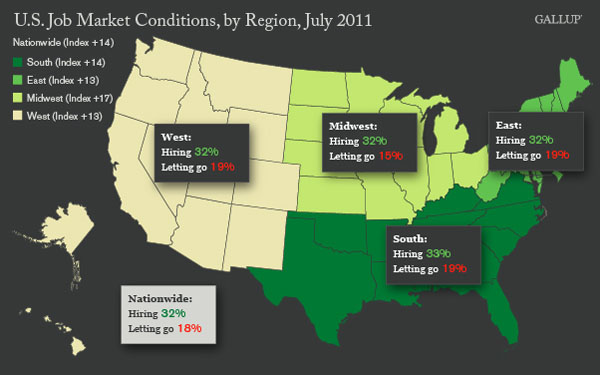PRINCETON, NJ -- Gallup's Job Creation Index was at +14 in July. This is not much different from the +15 of June and is the same as the +14 of May. Job creation continues to be flat -- it has been in the +12 to +15 range since February -- but remains above 2009 and 2010 levels, and below those of 2008.

Hiring and Firing Relatively Unchanged in 2011
The Job Creation Index score of +14 in July is based on 32% of workers nationwide saying their employers are hiring and 18% saying their employers are letting workers go. The percentage of employees saying their employer is reducing staff size has been in the 18% to 19% range over the past six months. The percentage saying their employer is hiring employees and expanding its workforce has been in the 30% to 32% range over the same period.

Job Market Conditions Are Best in the Midwest
Job market conditions appear slightly better in the Midwest than in other regions of the country, based on a Job Creation Index score of +17 in the Midwest and scores of +13 or +14 in the other three regions.

Implications
Many companies appear to be holding on to their workers, with 18% to 19% of workers saying their employers are letting employees go over the first seven months of 2011. This remains the case even though revised GDP data show the economy was stagnant during the first quarter of this year and didn't do much better during the second quarter.
Hiring has also remained virtually flat over the past six months, as Gallup's hiring measure has stayed in the 30% to 33% range. That is, employers appear to be holding back on their hiring during recent months. Companies may be concerned about how much business they expect to get in the future. This reduction in operating visibility seems to be hindering hiring, which is consistent with the weak jobless claims and job growth data the government has reported in recent months.
Looking ahead, neither the unexpectedly low GDP numbers nor Monday's surprisingly weak ISM report suggest good things for jobs. In this regard, Gallup's mid-month unemployment and underemployment data suggest a worsening of the government's unemployment rate when July numbers are reported on Friday.
The real question for the future course of the economy is whether the stagnation in the jobs market is simply a reflection of the overall economic stagnation in the first half of this year or whether it points to even weaker economic conditions in the second half. The sharp deterioration in Gallup's Economic Confidence Index in July suggests it may turn out to be the latter.
Gallup.com reports results from these indexes in daily, weekly, and monthly averages and in Gallup.com stories. Complete trend data are always available to view and export in the following charts:
Daily: Employment, Economic Confidence and Job Creation, Consumer Spending
Weekly: Employment, Economic Confidence, Job Creation, Consumer Spending
Read more about Gallup's economic measures.
View our economic release schedule.
Survey Methods
For Gallup Daily tracking, Gallup interviews approximately 1,000 national adults, aged 18 and older, each day. The Gallup Job Creation Index results are based on a random sample of approximately 500 current full- and part-time employees each day.
National results for July are based on Gallup Daily tracking interviews with 17,186 employees conducted July 1-31, 2011. For this sample, one can say with 95% confidence that the maximum margin of sampling error is ±1 percentage point. Regional results for May are based on interviews totaling more than 3,000 in each region. For each total regional sample, the maximum margin of sampling error is ±3 percentage points.
Interviews are conducted with respondents on landline telephones and cellular phones, with interviews conducted in Spanish for respondents who are primarily Spanish-speaking. Each sample includes a minimum quota of 400 cell phone respondents and 600 landline respondents per 1,000 national adults, with additional minimum quotas among landline respondents for gender within region. Landline telephone numbers are chosen at random among listed telephone numbers. Cell phone numbers are selected using random-digit-dial methods. Landline respondents are chosen at random within each household on the basis of which member had the most recent birthday.
Samples are weighted by gender, age, race, Hispanic ethnicity, education, region, adults in the household, and phone status (cell phone only/landline only/both, cell phone mostly, and having an unlisted landline number). Demographic weighting targets are based on the March 2010 Current Population Survey figures for the aged 18 and older non-institutionalized population living in U.S. telephone households. All reported margins of sampling error include the computed design effects for weighting and sample design.
In addition to sampling error, question wording and practical difficulties in conducting surveys can introduce error or bias into the findings of public opinion polls.
For more details on Gallup's polling methodology, visit www.gallup.com.
